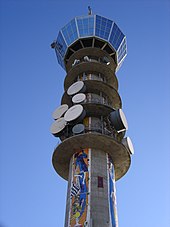History of radio § Broadcasting
Reception distance
VHF Radio
waves do not travel far beyond the visual horizon, so reception distances for FM
stations are usually limited to 30–40 miles (50–65 km) They can also
be blocked by hills or buildings.
The knife edge effect can permit reception
where there is no direct line of sight between broadcaster and receiver. The
reception can vary considerably depending on the position. One example is
the Učka mountain range, which makes
constant reception of Italian signals from Veneto and Marche possible in a good
portion of Rijeka, Croatia, despite the distance being
over 200 km. Other radio propagation effects such
as tropospheric
ducting and Sporadic E can occasionally allow
distant stations to be intermittently received, but cannot be relied on for
commercial broadcast purposes.
This is
still less than the range of AM radio waves, which because of their lower
frequency can travel as ground waves or
reflect off the ionosphere, so AM
radio stations can be received at hundreds (sometimes thousands) of miles. This
is a property of the carrier wave's typical frequency (and power), not its mode
of modulation.
The range
of FM transmission is related to the transmitter's RF power, the antenna gain, and antenna height. Interference from other
stations is also a factor in some places. In the U.S, the FCC publishes curves
that aid in calculation of this maximum distance as a function of signal
strength at the receiving location. Computer modelling is more commonly used for
this around the world.
Many FM
stations, especially those located in severe multipath areas, use extra audio
compression/processing to keep essential sound above the background
noise for listeners, occasionally at the expense of overall perceived sound
quality. In such instances, however, this technique is often surprisingly
effective in increasing the station's useful range.
Consumer
use of FM transmitters
In some
countries, small-scale (Part 15 in
United States terms) transmitters are available that can transmit a signal from
an audio device (usually an MP3 player or similar) to a standard
FM radio receiver; such devices range from small units built to carry audio to
a car radio with no audio-in capability (often formerly provided by special
adapters for audio cassette decks,
which are becoming less common on car radio designs) up to full-sized,
near-professional-grade broadcasting systems that can be used to transmit audio
throughout a property. Most such units transmit in full stereo, though some
models designed for beginner hobbyists might not. Similar transmitters are
often included in satellite radio receivers
and some toys.
Legality
of these devices varies by country. The U.S.
Federal Communications Commission and Industry Canada allow them. Starting
on 1 October 2006, these devices became legal in most countries in the European Union. Devices made to the
harmonised European specification became legal in the UK on 8 December 2006.[27]
The FM
broadcast band is also used by some inexpensive wireless microphones sold as toys for karaoke or similar purposes, allowing
the user to use an FM radio as an output rather than a dedicated amplifier and
speaker. Professional-grade wireless microphones generally use bands in
the UHF region
so they can run on dedicated equipment without broadcast interference.
Some
wireless headphones transmit
in the FM broadcast band, with the headphones tunable to only a subset of the
broadcast band. Higher-quality wireless headphones use infrared transmission or UHF ISM bands such as 315 MHz,
863 MHz, 915 MHz, or 2.4 GHz instead of the FM broadcast band.
Micro Broadcasting
Low-power
transmitters such as those mentioned above are also sometimes used for
neighborhood or campus radio stations, though campus radio stations are often
run over carrier current.
This is generally considered a form of micro broadcasting. As a general rule, enforcement
towards low-power FM stations is stricter than with AM stations, due to
problems such as the capture effect and
as a result, FM micro broadcasters generally do not reach as far as their AM
competitors.
Clandestine
use of FM Transmitters
FM
transmitters have been used to construct miniature wireless microphones
for espionage and surveillance purposes (covert listening
devices or so-called "bugs"); the advantage to using
the FM broadcast band for such operations is that the receiving equipment would
not be considered particularly suspect. Common practice is to tune the bug's
transmitter off the ends of the broadcast band, into what in the United States
would be TV channel 6 (<87.9 MHz) or aviation navigation frequencies
(>107.9 MHz); most FM radios with analog tuners have sufficient over coverage
to pick up these slightly-beyond-outermost frequencies, although many digitally
tuned radios have not.
Constructing
a "bug" is a common early project for electronics hobbyists, and
project kits to do so are available from a wide variety of sources. The devices
constructed, however, are often too large and poorly shielded for use in
clandestine activity.
In
addition, much pirate radio activity
is broadcast in the FM range, because of the band's greater clarity and
listenership, the smaller size and lower cost of equipment.





Comments
Post a Comment